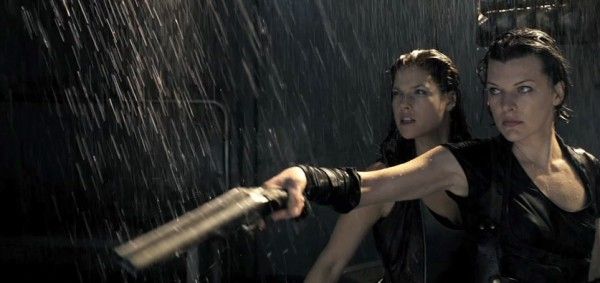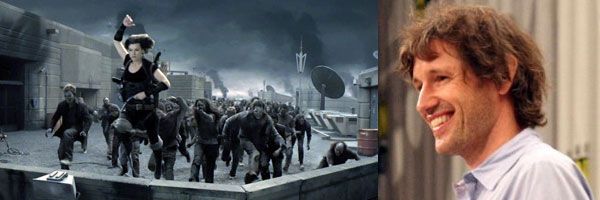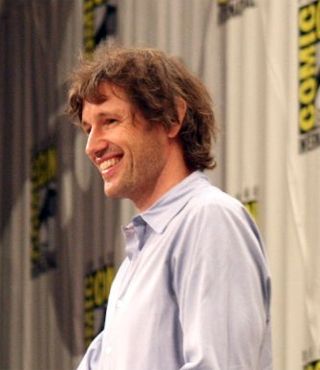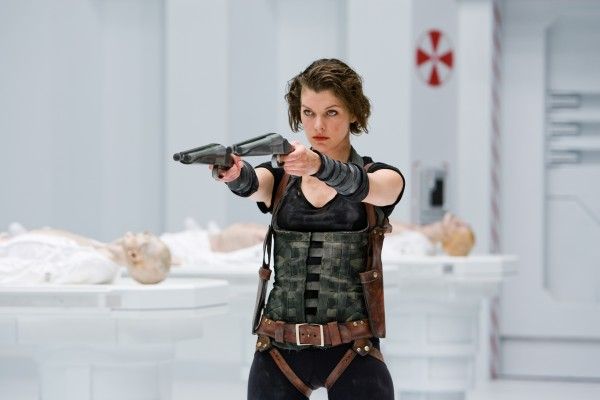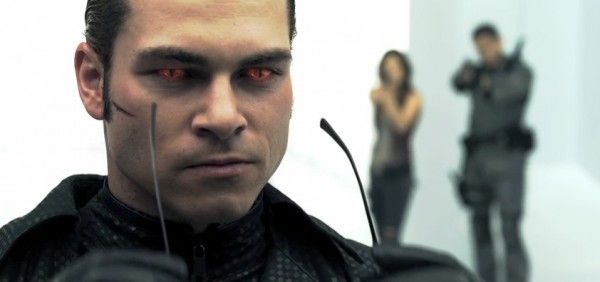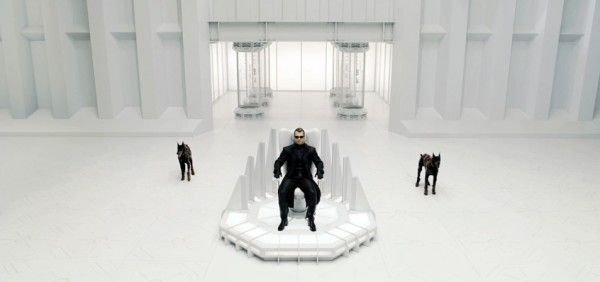Last November, when Resident Evil: Afterlife was filming in Toronto, I got to visit the set with a few other online journalists. While on set, we were able to talk with writer/director Paul W.S. Anderson even though he was incredibly busy. The thing to know is...while every director is always busy on a normal movie set, they were filming RE: Afterlife in 3D, which meant Anderson needed to focus on a lot more than just his normal director duties. Thankfully, he gave us a few minutes and we talked about what brought him back to the franchise, why 3D, what challenges he's been dealing with, how the movie is like the 5th video game, and a lot more. As always, I've provided both the transcript and the audio of the interview.
As always, you can either read the transcript below or listen to the audio by clicking here. And if you haven't seen the trailer for Resident Evil: Afterlife yet, I'd watch it first. Finally, I was able to interview Paul W.S. Anderson at this year's WonderCon, so click here if you missed it.
--
Question: Talk about coming back to this franchise as a director and what you brought you back and what you want to do with it that's different.
Anderson: I never really thought I went away because I've written all of the movies and I'm produced them all and certainly provided services about and beyond the average producer on two and three. I was on set most of the films and called action and cut a lot of times and did all that good stuff. And so, I was excited about the fourth movie I guess conceptually because, what I felt we should do it, we should try to make it a conceptual jump like Terminator did to T2. It was still the Terminator franchise, but it was something kind of bigger and grander. That was our idea with this Resident Evil, to make that kind of conceptual jump. It will still be Resident Evil, it will have all the really cool Resident Evil things in it - the characters from the game, the dogs that you've seen, but you know, the dogs on a new level. These dogs are a massive improvement on the dogs before. I think some of the sets we're building, the locations we're using, are giant. Again, like a big conceptual jump to try and make the movie kind of a bigger and grander event than the first trilogy was.
Was there a particular game? It seems like there's an aura of Resident Evil 5 over this one.
Anderson: Yes.
Were you surprised when you started playing that game?
Anderson: There were some surprises actually because I was writing the script before the game came out. Then the game came out and it had huge elements that were already in the screenplay. And, you know, talking to Capcom, Capcom's so funny. Every time I go to Japan and meet Capcom it is like going to see the Umbrella Corporation. You ask them things and they won't give you a straight answer about anything. I kind of knew, they would tell me that Wesker was in the game, kind of, but they would never really confirm it. And sure enough he was the main villain. He was the main villain in the movie as well. And completely by coincidence a large chunk of this movie takes place on a big ship and there was the ship from Resident Evil 5. We had the dogs in already. We had an awful lot of stuff that they had already put into Resident Evil 5 so what I did was, I just did a whole big pass on the script to kind of bring it more in line with the imagery of the latest game because I thought the latest game was fantastic. I thought it kind of reinvented the video game franchise and I wanted to take a lot of that, frankly kind of steal from it and put it in the movie.
There's a whole fight scene that we're about to shoot that we start next week with Ali Larter and Wentworth Miller which is taken almost, well is taken shot-by-shot from Resident Evil 5. Basically all the heads of department have a play out of the game. It's where Chris is fighting Wesker and, it's Chiva from Resident Evil 5 game. Anyway, the two of them are fighting Wesker and the character from the game, we're putting Claire in there, so it's brother and sister fighting against Wesker. What's great in the game is it's one continuous shot where the camera rotates around Wesker fighting the two and he just kicks their asses. But they never cut, which of course you can do in animation. It's a bit more difficult in live action. So what we're going to do is we're probably going to shoot the fight in ten different segments and then seam it together in visually effects so the finished effect will be as though the camera never stops rotating around. It's really cool because you go around them and then you kind of go underneath. It's going to be a nightmare and everyone's tearing their hair out on set trying to figure out how to do it, especially with the 3-D rigs, which are huge. You've probably noticed that. It's a very different experience shooting in 3-D because the camera rigs are so large. Everything we've become accustomed to in the last ten years as filmmakers, which is cameras getting smaller and smaller and you can just throw them on your shoulder and stick them in a car and do whatever you want, you can't do any of that now. You're forced to put things on dollies and track and cranes. It's kind of like a throwback to an old school way of filmmaking. So for this kind of very flexible shoot, we're having to reinvent the wheel a little bit.
In terms of the story, how do you re-conceptualize the Resident Evil movie for 3-D with this change in the way you have to shoot it?
Anderson: I wrote a script that I felt kind of emphasized depth because I think that's very suitable to 3-D, obviously. But I kind of feel like I've always directed movies a little like they were ride films anyway. I mean, I've used that terms a lot in the films I've directed from Even Horizon onwards. There's a scene in Event Horizon where the characters go through this tunnel that rotates and that was taken directly off a ride at Universal Studios where it fucked with your equilibrium. I've been very into that and I've often referred to ride films. The Back to the Future ride and things like that, because they're very immersive. I've always tried to do camera moves that I felt were immersive. So I think, as a filmmaker, my style of filmmaking is very well-suited to 3-D anyway, so it's not like I'm having to change a huge amount of the way I shoot to work in 3-D. I think you could probably dimensionalize some of my movies and they would make very good 3-D films because they're full of, like, tentacles coming out, certainly, lots of depth and...
At what point did you realize you wanted to get back into the director's chair for Resident Evil?
Anderson: To tell the truth, I've kind of always wanted to be there. It's been a very difficult decision for the last two when I couldn't. It was always kind of clashing schedules. You know, I had the opportunity to work with Aliens and Predators when Resident Evil 2 was being made and it was for two different studios. It was for Fox and Sony. They don't care about one another. They just want their movies. So it was very difficult to delay one and... So I had to make a very painful decision to kind of step away from directing the second movie and with the third movie it was the same. I had this movie, Death Race, that was a passion project for me that I'd had in development for almost ten years. Suddenly it was kind of igniting. Again I found it difficult to direct both movies, although on the last Resident Evil I was on set for almost every single day of principal photography. On this film I was fortunate that, hopefully my next movie is this version of Three Musketeers that we're trying to fast track right now and it's for the same company that Resident Evil is. I've been fortunate that I don't have any clashes right now, so as soon as that became apparent I jumped into the director's chair. They didn't have to wait to put my name on the back of it.
That's going to be 3-D as well, right?
Anderson: Yes. I'm a big 3-D convert.
You feel like you're not going to go back now?
Anderson: I don't think so. I really believe in 3-D. I really think it is the wave of the future for cinema. I certainly as a filmmaker feel like it's like you're directing a talkie for the first time when talkies were the new thing. It's a really exciting medium to work in. And you really feel like you're on the cutting edge and you know you are because all the camera equipment you take for granted doesn't exist for 3-D. So all the cranes with all the stabilized heads, they don't work on 3-D because they're all built for lightweight camera packages. As soon as you kind of put two cameras together and all the other crap that they need and the cabling to go back to the computers, we've literally, the cranes on these movies, they break after a couple of days. You can see them, they're kind of jittering and then all the gears burn out. So we're having to build our own heads, build our own cranes. There's no such thing as motion control that exists for 3-D. Again, because motion control, all the gearing is for lightweight cameras. So we're having to build our own motion control rigs. We did a lot of helicopter shooting in L.A. and also in Alaska which looks fantastic but we had terrible problems because the helicopters weren't built to carry the weight of two cameras, so we'd have real problems with the helicopters, kind of like the pilots going, "Fuck, I can't fly this thing and get you the shot you want." It's been very, very difficult, but I think the plus side is you know you're getting something very, very exciting.
Are you a fan of 3-D games?
Anderson: Yeah, absolutely. I mean, I think 3-D across the board both in a home format and cinema is, it's going to be very big.
Milla said she'd never seen a 3-D movie. Were you a fan of 3-D cinema going back to older releases?
Anderson: I saw Spacehunter 3-D. It gave me a headache. Yeah, I mean I saw all those old movies, absolutely, with the red and the blue glasses. But I think they're all very gimmicky and I think the difference is now that people are trying to make more serious mainstream movies that are not just kind of like, they're not just William Castle kind of gimmick films.
Is there a 3-D movie that you think makes the best use of the technology now?
Anderson: I mean, Up was, I think what was great about it, because I've pretty much seen every 3-D movie made in anticipation for making this film. What was great about Up and also about Coraline... Coraline is probably I think my favorite 3-D movie because there are, it uses both negative and positive space really well. Cameron is very public about it. He feels like positive space, you shouldn't use it. Everything should be positive space. It should be a window into a world where you kind of peer into another world. And then there are filmmakers who have done 3-D movies that can't get enough positive space and can't get enough crap kind of poking at the camera out of the screen. I kind of feel like the best movies, for me anyways so far, combine a combination of both. Coraline I thought was really good because it used a lot of negative space so that you knew you were watching a 3-D movie, but it had like six or seven big moments where it used the positive space where stuff actually came out of the screen. Because it was used in a sparing way, it was very, very impactful.
Is that what we can expect in this as well?
Anderson: That's what I'm trying to do, but you know, I'm me so I probably won't be able to contain myself to seven or eight big moments. But we are, Packer who's our stereographer, he kind of keeps an eye on that all the time. He'll tell you, we have been very restrained in the use of 3-D at certain times. So it's not always in your face. But then we definitely have some big 3-D moments.
--
For more Resident Evil: Afterlife coverage:
Milla Jovovich on set interview
Resident Evil: Afterlife set report

